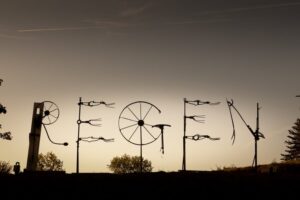
The last dairy farmer in St Ouen would have to ‘sell up and cease trading’ if his land is developed as suitable for the construction if 77 new homes.
Two fields to the west of St Ouen’s Village have been proposed for development by the Environment Minister under his ‘Plan B’ proposals, although they have been the subject of no less than three previous examinations by independent Inspectors and on each occasion have been rejected.
The location of the fields, Nos 622 and 623, are located at the village end of La Route du Marais, bordered by the lane La Rue de la Croute. They have now been proposed for rezoning within the new Island Plan, although none of the factors that led to the former rejections have changed.
Due to the significant size of the possible development, many of these factors have been ‘substantially exacerbated’, according to neighbours Robert and Rosemary Blackmore. They have written a letter to all States Members drawing their attention to the proposed development and to its previous Planning history.
Rosemary Blackmore said: ‘Although we do indeed live very close to two of the fields but this is much more than ” Nimbyism”. We are equally concerned about the other fields threatened with development and the effect of losing viable green zone land in our beautiful parish cannot be underestimated.
‘These fields are of considerable historical, environmental and agricultural importance. They are protected by the Green Zone and there are two farmers, one arable and one dairy, who rely on these fields for their livelihoods. Indeed, it is clear that if these fields are taken out of the agricultural land bank, then the last dairy farmer in St Ouen will have to sell up and cease trading.
‘It is shocking to us that such a thing is even able to be within the contemplation of the Parish authorities of such a rural Parish.’
Mr and Mrs Blackmore feel that there are a number of reasons that make this proposal entirely ‘inappropriate and unsupportable’.
‘We think fundamentally this is a shocking example of the complete disregard for the exhaustive, extensive and costly process previously undertaken relating to this land which followed the Island’s policy to the letter on such matters.
‘It appears to us that the planning history of this land is now to be completely ignored and the proverbial “dead horse” is being flogged once again. Surely this completely undermines the integrity of such a policy/process as well as at great cost to not just the Parish but the Jersey tax payer? Is this not, at the very least, highly embarrassing for the Island?
Among their concerns is the ability to form a suitable and safe access to the fields. They understand that the intention is to create an exit on to La Route du Marais.
‘This is already a very busy road and field 623 borders the road immediately to the east of a blind bend after the long straight heading from Mont Pinel. Without substantial encroachment on to field 623 and adjoining properties, it is impossible to create the necessary sight lines to ensure a safe exit onto the main road.’
The marsh, which is designated as an SSI, is in very close proximity to the fields. ‘As an SSI, every effort should be made to ensure its continued health and survival. The fields’ natural drainage would lead to a very real likelihood of not only flooding and substantial damage to the marsh but also to flooding in Rue de la Croute and Route de Marais.
‘We understand that this is one of the reasons that the planning office has always said that any future development of St Ouen’s village should be to the east of the existing village and that no further development should take place to the west of the village. These fields lie directly to the west of the existing houses. There is no doubt that any development of these fields will significantly damage the marsh and threaten the vital flora and fauna within the SSI.’
In their letter to States Members, they write: ‘The idea of building 77 homes on this land is astounding. The strain on the existing infrastructure would be huge. In addition to the access and vehicular challenges (likely to be well over 100 additional vehicles within the development), there would need to be a substantial investment in upgrading the current utilities and other services. There is no doubt that this would for ever change the character of this rural village.
‘We are at a loss to understand why the Environment Minister has decided these fields should be rezoned for affordable housing under the new Island Plan given their history of rejection. Has he fully researched all of the other numerous Brown Field sites in the area?
‘We appreciate, of course, that there is a serious housing crisis, but removing fields from agricultural use will not solve the problem until population levels are addressed. It will mean, amongst other things, that our Island will have to rely more and more on imported food, rather than locally grown.’
They are also encouraging anyone concerned about the loss of good viable green zone land to write independently to the JEP’s letters page, ‘as the more people know of these plans the better’.
They state in their letter: ‘This issue has been going on for many years, at considerable cost not only to the parish but to the whole Island. Once independent enquiries from the UK deemed the fields unsuitable for development, we really hoped that would be the end of it.
‘The “Field 622 saga” is probably one of the most scrutinised planning applications/considerations that have taken place in the last decade and surely that is more than sufficient ‘due consideration’ and we are at a loss to understand why that is not a valid reason to no longer pursue it.’
The Draft Bridging Island Plan, including the last-minute amendments, is to be debated by The States Assembly in early March.





